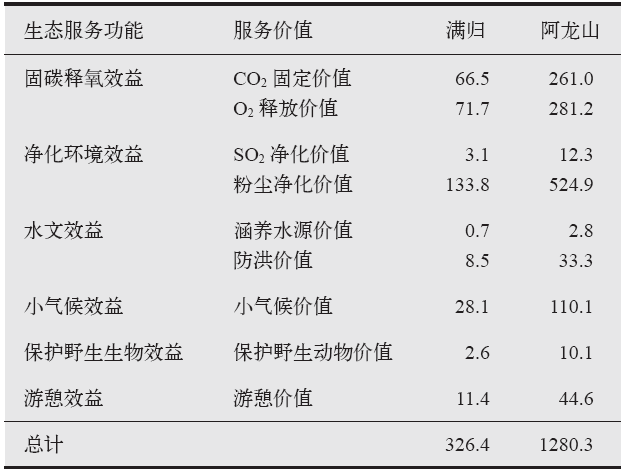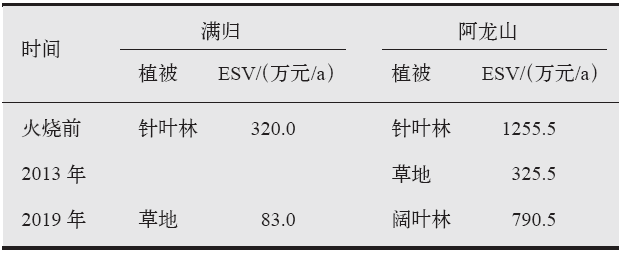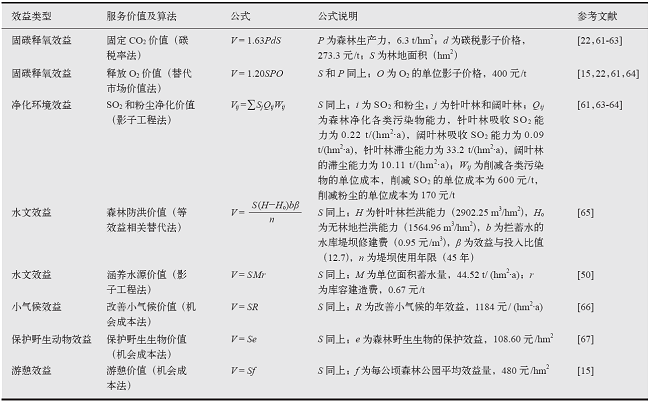气候变化研究进展 ›› 2020, Vol. 16 ›› Issue (5): 545-554.doi: 10.12006/j.issn.1673-1719.2020.019
多年冻土区森林大火对生态服务功能的影响研究
李晓英1,2,3, 金会军2,3,4( ), 何瑞霞3, 黄亚冬3
), 何瑞霞3, 黄亚冬3
- 1 东北林业大学林学院森林生态系统可持续经营教育部重点实验室/北方林火管理国家林草局重点实验室,哈尔滨 150040
2 东北林业大学寒区工程与科学技术研究院/东北多年冻土区地质环境系统教育部野外科学观测研究站,哈尔滨 150040
3 中国科学院西北生态环境资源研究院冻土工程国家重点实验室,兰州 730000
4 东北林业大学土木工程学院,哈尔滨 150040
-
收稿日期:2020-02-03修回日期:2020-03-24出版日期:2020-09-30发布日期:2020-09-30 -
通讯作者:金会军 -
作者简介:李晓英,女,副教授 -
基金资助:国家自然科学基金项目(41871052);冻土工程国家重点实验室自主课题(SKLFSE-ZT-20)
Effects of forest fires on ecological service in permafrost regions
LI Xiao-Ying1,2,3, JIN Hui-Jun2,3,4( ), HE Rui-Xia3, HUANG Ya-Dong3
), HE Rui-Xia3, HUANG Ya-Dong3
- 1 Key Laboratory of Sustainable Forest Ecosystem Management of Ministry of Education/ Northern Forest Fire Management Key Laboratory of the State Forestry and Grassland Bureau, College of Forestry, Northeast Forestry University, Harbin 150040, China
2 Institute of Cold-Regions Engineering Science and Technology/ Northeast-China Observatory and Research-Station of Permafrost Geo-Environment of Ministry of Education, Northeast Forestry University, Harbin 150040, China
3 State Key Laboratory of Frozen Soils Engineering, Northwest Institute of Eco-Environment and Resources, Chinese Academy of Sciences, Lanzhou 730000, China
4 School of Civil Engineering, Northeast Forestry University, Harbin 150040, China
-
Received:2020-02-03Revised:2020-03-24Online:2020-09-30Published:2020-09-30 -
Contact:JIN Hui-Jun
摘要:
在气候变暖背景下,大兴安岭森林大火导致多年冻土退化,植被发生更新和演替,对森林生态系统服务功能造成重要影响。文中选取大兴安岭北部多年冻土区满归和阿龙山火烧区为研究对象,通过定量方法计算了林火后,固碳释氧效益损失;净化环境效益损失,包括吸收SO2和粉尘净化价值;水文效益损失,包括防洪和涵养水源效益;小气候效益损失;保护野生生物以及游憩效益损失。研究发现,满归和阿龙山火烧后,生态系统服务效益损失重大。其中,固碳释氧效益和净化环境效益损失较大,分别占总效益损失的42.34%和41.94%;水文效益和保护野生生物效益损失较小,分别为2.82%和0.80%;小气候效益和游憩效益居中,分别占8.61%和3.49%。即使针叶林生态系统恢复到阔叶林生态系统,净化环境效益损失仍然可达69.3%。由此看来,保护多年冻土区的针叶林,减少森林火灾的发生对维持多年冻土区森林生态系统的稳定性和可持续发展至关重要。
引用本文
李晓英, 金会军, 何瑞霞, 黄亚冬. 多年冻土区森林大火对生态服务功能的影响研究[J]. 气候变化研究进展, 2020, 16(5): 545-554.
LI Xiao-Ying, JIN Hui-Jun, HE Rui-Xia, HUANG Ya-Dong. Effects of forest fires on ecological service in permafrost regions[J]. Climate Change Research, 2020, 16(5): 545-554.

图1 大兴安岭多年冻土研究区和研究站点分布图 (基于Jin等[56]和周幼吾等[60]修改)
Fig. 1 Study region and sites in the permafrost region in the northern Greater Hinggan Mountains, Northeast China (Modified from [56] and [60])
 |
表2 满归和阿龙山火烧前针叶林生态服务功能价值 万元/a
Table 2 Ecological service values of Mangui and Alongshan in coniferous forest in the northern Greater Hinggan Mountains, Northeast China
 |
 |
表3 火烧前后,大兴安岭北部满归和阿龙山研究区生态系统服务价值(ESV)变化
Table 3 Changes in ecological service values (ESV) of coniferous forest in Mangui and Alongshan in the northern Greater Hinggan Mountains, Northeast China
 |
| [1] | Costanza R, d'Arge R, de Groot R, et al. The value of the world’s ecosystem services and natural capital[J]. Nature, 1997,387(15):253-260 |
| [2] | Millennium Ecosystem Assessment. Ecosystems and human well-being: synthesis [M]. Washington, DC: Island Press, 2005 |
| [3] | Kubiszewski I, Costanza R, Anderson S, et al. The future value of ecosystem services: global scenarios and national implications[J]. Ecosystem Services, 2017,26:289-301 |
| [4] | Xie G, Zhang C, Zhen L, et al. Dynamic changes in the value of China’s ecosystem services[J]. Ecosystem Services, 2017,26:146-154 |
| [5] | Kumar P. The economics of ecosystems and biodiversity (TEEB) ecological and economic foundations[M]. London and Washington: Earthscan, 2010 |
| [6] |
Ouyang Z, Zheng H, Xiao Y, et al. Improvements in ecosystem services from investments in natural capital[J]. Science, 2016,352(6292):1455-1459
doi: 10.1126/science.aaf2295 URL pmid: 27313045 |
| [7] | Braat L, de Groot R. The ecosystem services agenda: bridging the worlds of natural science and economics, conservation and development, and public and private policy[J]. Ecosystem Services, 2012,1(1):4-15 |
| [8] | Study of Critical Environmental Problems. Man’s impact on the global environment: assessment and recommendations for action [M]. Cambridge, MA: MIT Press, 1970 |
| [9] | Turner K, Anderson S, Gonzaleschang M, et al. A review of methods, data, and models to assess changes in the value of ecosystem services from land degradation and restoration[J]. Ecological Modelling, 2016,319:190-207 |
| [10] | Tolessa T, Senbeta F, Kidane M, et al. The impact of land use/land cover change on ecosystem services in the central highlands of Ethiopia[J]. Ecosystem Services, 2017,23:47-54 |
| [11] | Luck G, Chan K, Fay J, et al. Protecting ecosystem services and biodiversity in the world’s watersheds[J]. Conservation Letters, 2009,2(4):179-188 |
| [12] | Pauutanayak S. Valuing watershed services: concepts and empirics from Southeast Asia[J]. Agriculture Ecosystems Environment, 2004,104:171-184 |
| [13] |
Turner R, Den Bergh J, Soderqvist T, et al. Ecological-economic analysis of wetlands: scientific integration for management and policy[J]. Ecological Economics, 2000,35(1):7-23
doi: 10.1016/S0921-8009(00)00164-6 URL |
| [14] |
Bandara R, Tisdell C. The net benefit of saving the Asian elephant: a policy and contingent valuation study[J]. Ecological Economics, 2004,48(1):93-107
doi: 10.1016/j.ecolecon.2003.01.001 URL |
| [15] | 欧阳志云, 王如松, 赵景柱. 生态系统服务功能及其生态经济价值评价[J]. 应用生态学报, 1999,10(5):635-640. |
| Ouyang Z Y, Wang R S, Zhao J Z. Ecosystem services and their economic valuation[J]. Chinese Journal of Applied Ecology, 1999,10(5):635-640 (in Chinese) | |
| [16] | 欧阳志云, 王效科, 苗鸿. 中国陆地生态系统服务功能及其生态经济价值的初步研究[J]. 生态学报, 1999,19(5):607-613. |
| Ouyang Z Y, Wang X K, Miao H. A primary study on Chinese terrestrial ecosystem services and their ecological-economic values[J]. Acta Ecologica Sinica, 1999,19(5):607-613 (in Chinese) | |
| [17] |
赵同谦, 欧阳志云, 王效科, 等. 中国陆地地表水生态系统服务功能及其生态经济价值评价[J]. 自然资源学报, 2003,18(4):443-452.
doi: 10.11849/zrzyxb.2003.04.008 URL |
| Zhao T Q, Ouyang Z Y, Wang X K, et al. Ecosystem services and their valuation of terrestrial surface water system in China[J]. Journal of Natural Resources, 2003,18(4):443-452 (in Chinese) | |
| [18] |
谢高地, 张钇锂, 鲁春霞, 等. 中国自然草地生态系统服务价值[J]. 自然资源学报, 2001,16(1):47-53.
doi: 10.11849/zrzyxb.2001.01.008 URL |
| Xie G D, Zhang Y L, Lu C X, et al. Study on valuation of rangeland ecosystem services of China[J]. Journal of Natural Resources, 2001,16(1):47-53 (in Chinese) | |
| [19] |
Schirpke U, Kohler M, Leitinger G, et al. Future impacts of changing land-use and climate on ecosystem services of mountain grassland and their resilience[J]. Ecosystem Services, 2017,26:79-94
doi: 10.1016/j.ecoser.2017.06.008 URL pmid: 31110934 |
| [20] | 靳芳, 鲁绍伟, 余新晓, 等. 中国森林生态系统服务功能及其价值评价[J]. 应用生态学报, 2005,16(8):1531-1536. |
| Jin F, Lu S W, Yu X X, et al. Forest ecosystem service and its evaluation in China[J]. Chinese Journal of Applied Ecology, 2005,16(8):1531-1536 (in Chinese) | |
| [21] | 余新晓, 鲁绍伟, 靳芳. 中国森林生态系统服务功能价值评估[J]. 生态学报, 2005,25(8):2096-2102. |
| Yu X X, Lu S W, Jin F. The assessment of the forest ecosystem services evaluation in China[J]. Acta Ecologica Sinica, 2005,25(8):2096-2102 (in Chinese) | |
| [22] | 徐俏, 何孟常, 杨志峰, 等. 广州市生态系统服务功能价值评估[J]. 北京师范大学学报:自然科学版, 2003,39(2):268-272. |
| Xu Q, He M C, Yang Z F, et al. Assessment on urban ecosystem services of Guangzhou city[J]. Journal of Beijing Normal University: Natural Science, 2003,39(2):268-272 (in Chinese) | |
| [23] | 肖玉, 谢高地, 安凯. 莽措湖流域生态系统服务功能经济价值变化研究[J]. 应用生态学报, 2003,14(5):676-680. |
| Xiao Y, Xie G D, An K. Economic value of ecosystem services in Mangcuo Lake drainage basin[J]. Chinese Journal of Applied Ecology, 2003,14(5):676-680 (in Chinese) | |
| [24] | 吴玲玲, 陆健健, 童春富, 等. 长江口湿地生态系统服务功能价值的评估[J]. 长江流域资源与环境, 2003,12(5):411-416. |
| Wu L L, Lu J J, Tong C F, et al. Valuation of wetland ecosystem services in the Yangtze River Estuary[J]. Resources and Environment in the Yangtze Basin, 2003,12(5):411-416 (in Chinese) | |
| [25] | 辛琨, 肖笃宁. 盘锦地区湿地生态系统服务功能价值估算[J]. 生态学报, 2002,22(8):1345-1349. |
| Xin K, Xiao D N. Wetland ecosystem service valuation a case researches on Panjin area[J]. Acta Ecologica Sinica, 2002,22(8):1345-1349 (in Chinese) | |
| [26] | 谢高地, 鲁春霞, 冷允法, 等. 青藏高原生态资产的价值评估[J]. 自然资源学报, 2003,18(2):189-196. |
| Xie G D, Lu C X, Leng Y F, et al. Ecological assets valuation of the Tibetan Plateau[J]. Journal of Natural Resources, 2003,18(2):189-196 (in Chinese) | |
| [27] | Xie G, Zhen L, Lu C, et al. Expert knowledge based valuation method of ecosystem services in China[J]. Journal of Natural Resources, 2008,23:911-919 |
| [28] | 赵军, 杨凯. 生态系统服务价值评估研究进展[J]. 生态学报, 2007,27(1):346-356. |
| Zhao J, Yang K. Valuation of ecosystem services: characteristics, issues and prospects[J]. Acta Ecologica Sinica, 2007,27(1):346-356 (in Chinese) | |
| [29] | 陈美球, 赵宝苹, 罗志军, 等. 基于RS与GIS的赣江上游流域生态系统服务价值变化[J]. 生态学报, 2013,33(9):2761-2767. |
| Chen M Q, Zhao B P, Luo Z J, et al. The ecosystem services value change in the upper reaches of Ganjiang River based on RS and GIS[J]. Acta Ecologica Sinica, 2013,33(9):2761-2767 (in Chinese) | |
| [30] | 赵同谦, 欧阳志云, 贾良清, 等. 中国草地生态系统服务功能间接经济价值评价[J]. 生态学报, 2004,24(6):1101-1110. |
| Zhao T Q, Ouyang Z Y, Jia L Q, et al. Ecosystem services and their valuation of China grassland[J]. Acta Ecologica Sinica, 2004,24(6):1101-1110 (in Chinese) | |
| [31] | 黄从红, 杨军, 张文娟. 生态系统服务功能评估模型研究进展[J]. 生态学杂志, 2013,32(12):3360-3367. |
| Huang C H, Yang J, Zhang W J. Development of ecosystem services evaluation models: research progress[J]. Chinese Journal of Ecology, 2013,32(12):3360-3367 (in Chinese) | |
| [32] | Kareiva P, Marvier M. Conserving biodiversity coldspots[J]. American Scientist, 2003,91(4):344-351 |
| [33] | Niu X, Wang B, Liu S, et al. Economical assessment of forest ecosystem services in China: characteristics and implications[J]. Ecological Complexity, 2012,11:1-11 |
| [34] | Zhang D, Min Q, Liu M, et al. Ecosystem service tradeoff between traditional and modern agriculture: a case study in Congjiang county, Guizhou province, China[J]. Frontiers of Environmental Science & Engineering in China, 2012,6(5):743-752 |
| [35] |
Wen L, Dong S, Li Y, et al. Effect of degradation intensity on grassland ecosystem services in the alpine region of Qinghai-Tibetan Plateau, China[J]. PLoS ONE, 2013,8(3):e58432. DOI: 10.1371/journal.pone.0058432
doi: 10.1371/journal.pone.0058432 URL pmid: 23469278 |
| [36] | Zhang B, Li W, Xie G, et al. Ecosystem services research in China: progress and perspective[J]. Ecological Economics, 2010,69(7):1389-1395 |
| [37] | Sun J. Research advances and trends in ecosystem services and evaluation in China[J]. Procedia Environmental Sciences, 2011,10:1791-1796 |
| [38] | Yu Z, Bi H. Status quo of research on ecosystem services value in China and suggestions to future research[J]. Energy Procedia, 2011,5:1044-1048 |
| [39] |
Costanza R, de Groot R, Sutton P, et al. Changes in the global value of ecosystem services[J]. Global Environmental Change-Human and Policy Dimensions, 2014,26(26):152-158
doi: 10.1016/j.gloenvcha.2014.04.002 URL |
| [40] | 陈仲新, 张新时. 中国生态系统效益的价值[J]. 科学通报, 2000,45(1):17-22. |
| Chen Z X, Zhang X S. The value of Chinese ecological system benefit[J]. Chinese Science Bulletin, 2000,45(10):870-876. DOI: 10.1007/BF02886190 (in Chinese) | |
| [41] | 石垚, 王如松, 黄锦楼, 等. 中国陆地生态系统服务功能的时空变化分析[J]. 科学通报, 2012,57(17):720-731. |
| Shi Y, Wang R S, Huang J L, et al. An analysis of the spatial and temporal changes in Chinese terrestrial ecosystem service functions[J]. Chinese Science Bulletin, 2012,57(17):2120-2131. DOI: 10.1007/s11434-012-4978-5 (in Chinese) | |
| [42] | Cabral P, Feger C, Levrel H, et al. Assessing the impact of land-cover changes on ecosystem services: a first step toward integrative planning in Bordeaux, France[J]. Ecosystem Services, 2016,22:318-327 |
| [43] | Wang W, Guo H, Chuai X, et al. The impact of land use change on the temporospatial variations of ecosystems services value in China and an optimized land use solution[J]. Environmental Science & Policy, 2014,44:62-72 |
| [44] | 胡艳琳, 戚仁海, 由文辉, 等. 城市森林生态系统生态服务功能的评价[J]. 南京林业大学学报: 自然科学版, 2005,29(3):111-114. |
| Hu Y L, Qi R H, You W H, et al. Ecological service functional assessment on forest ecological system of Kunshan city[J]. Journal of Nanjing Forestry University: Natural Sciences Edition, 2005,29(3):111-114 (in Chinese) | |
| [45] | Tao Z, Yan H, Zhan J. Economic valuation of forest ecosystem services in Heshui watershed using contingent valuation method[J]. Procedia Environmental Sciences, 2012,13:2445-2450 |
| [46] | 汤萃文, 陶玲, 杨国靖, 等. 祁连山典型林区生态服务功能间接价值估算[J]. 生态学杂志, 2011,30(3):569-575. |
| Tang C W, Tao L, Yang G J, et al. Estimation of indirect values of forest ecosystem services in a typical forest area of Qilian Mountains[J]. Chinese Journal of Ecology, 2011,30(3):569-575 (in Chinese) | |
| [47] | Alarcon G, De Freitas L, Fountoura G, et al. The challenges of implementing a legal framework for payment for ecosystem services in Santa Catarina, Brazil[J]. Natureza & Conservacao, 2016,14(2):132-136 |
| [48] | Minsley B, Pastick N, Wylie B, et al. Evidence for nonuniform permafrost degradation after fire in boreal landscapes[J]. Journal of Geophysical Research: Earth Surface, 2016,121:320-335 |
| [49] | Flannigan M, Stocks B, Turetsky M, et al. Impacts of climate change on fire activity and fire management in the circumboreal forest[J]. Global Change Biology, 2009,15(3):549-560 |
| [50] | 苏丹, 陈珂, 祝业平, 等. 老秃顶子自然保护区生态系统服务效益计量[J]. 西北林学院学报, 2009,24(2):224-228. |
| Su D, Chen K, Zhu Y P, et al. Assessment of ecosystem services benefit for Laotudingzi nature reserve[J]. Journal of Northwest Forestry University, 2009,24(2):224-228 (in Chinese) | |
| [51] | 刘斌. 大兴安岭林火动态变化[D]. 北京: 中国林业科学研究院, 2011. |
| Liu B. The fire regime in Daxing’anling region[D]. Beijing: Chinese Academy of Forestry Sciences, 2011 (in Chinese) | |
| [52] | Bond-Lamberty B, Smith A, Bailey V. Temperature and moisture effects on greenhouse gas emissions from deep active-layer boreal soils[J]. Biogeosciences, 2016,13(24):6669-6681 |
| [53] |
Pellegrini A, Ahlström A, Hobbie S, et al. Fire frequency drives decadal changes in soil carbon and nitrogen and ecosystem productivity[J]. Nature, 2018,553(7687):194-198
doi: 10.1038/nature24668 URL pmid: 29227988 |
| [54] | Li X, Jin H, Wang H, et al. Distributive features of soil carbon and nutrients in permafrost regions affected by forest fires in northern Da Xing’anling (Hinggan) Mountains, NE China[J]. Catena, 2019,185:104304. DOI: 10.1016/j.catena.2019.104304 |
| [55] |
Pan Y, Birdsey R, Fang J, et al. A large and persistent carbon sink in the world’s forests[J]. Science, 2011,333(6045):988-993
doi: 10.1126/science.1201609 URL pmid: 21764754 |
| [56] | Jin H, Yu Q, Lü L, et al. Degradation of permafrost in the Xing’anling Mountains, northeastern China[J]. Permafrost and Periglacial Processes, 2007,18(3):245-258 |
| [57] | Jin H, Chang X, Luo D, et al. Evolution of permafrost in Northeast China since the Late Pleistocene[J]. Sciences in Cold and Arid Regions, 2016,8(4):269-296 |
| [58] | Chu T, Guo X, Takeda K. Effects of burn severity and environmental conditions on post-fire regeneration in Siberian larch forest[J]. Forests, 2017,8(3):76. DOI: 10.3390/f8030076 |
| [59] | Gibson C, Turetsky M, Cottenie K, et al. Variation in plant community composition and vegetation carbon pools a decade following a severe fire season in interior Alaska[J]. Journal of Vegetation Science, 2016,27(6):1187-1197 |
| [60] | 周幼吾, 郭东信, 邱国庆, 等. 中国冻土[M]. 北京: 科学出版社, 2000. |
| Zhou Y W, Guo D X, Qiu G Q, et al. Geocryology in China [M]. Beijing: Science Press, 2000 (in Chinese) | |
| [61] | 国家环境保护局. 中国生物多样性国情研究报告[M]. 北京: 中国环境科学出版社, 1998. |
| National Environmental Protection Agency. Research report on biodiversity in China [M]. Beijing: China Environmental Science Press, 1998 (in Chinese) | |
| [62] | 刘喜云, 孙向阳, 夏朝宗, 等. 东北地区森林植被生产力遥感定量估测[J]. 林业资源管理, 2007 (6):78-83. |
| Liu X Y, Sun X Y, Xia C Z, et al. RS-based monitoring of forest net primary productivity in Northeast China[J]. Forest Resources Management, 2007 (6):78-83 (in Chinese) | |
| [63] | Ninan K, Inoue M. Valuing forest ecosystem services: case study of a forest reserve in Japan[J]. Ecosystem Services, 2013,5:78-87 |
| [64] | 李俊梅, 朱福进, 段昌群, 等. 云南典型自然保护区生态系统服务效益计量: 以西双版纳勐腊自然保护区为例[J]. 生态经济: 学术版, 2007 (2):367-371. |
| Li J M, Zhu F J, Duan C Q, et al. Assessment of ecosystem services benefit for Mengla nature reserve in Xishuangbanna[J]. Ecological Economy: Academic Edition, 2007 (2):367-371 (in Chinese) | |
| [65] | 朱万昌, 梁延海, 张静, 等. 黑龙江省大兴安岭森林功能研究[J]. 中国造纸学报, 2004,19:S453-S456. |
| Zhu W C, Liang Y H, Zhang J, et al. Study on forest function of Daxing’an Mountains in Heilongjiang province[J]. Transactions of China Pulpand Pater, 2004,19:S453-S456 (in Chinese) | |
| [66] | 周国逸, 闫俊华. 生态公益林补偿理论与实践[M]. 北京: 气象出版社, 2000. |
| Zhou G Y, Yan J H. Compensation theory and practice of ecological public welfare forest [M]. Beijing: China Meteorological Press, 2000 (in Chinese) | |
| [67] | 郎奎建, 李长胜, 殷有, 等. 林业生态工程10种森林生态效益计量理论和方法[J]. 东北林业大学学报, 2000,28(1):1-7. |
| Lang K J, Li C S, Yin Y, et al. The measurement theory and method of 10 forest ecological benefits for forestry ecological engineering[J]. Journal of Northeast Forestry University, 2000,28(1):1-7. DOI: 10.13759/j.cnki.dlxb.2000.01.001 (in Chinese) | |
| [68] | 岳书平, 张树文, 闫业超. 东北样带土地利用变化对生态服务价值的影响[J]. 地理学报, 2007,62(8):879-886. |
| Yue S P, Zhang S W, Yan Y C. Impacts of land use change on ecosystem services value in the Northeast China transect[J]. Acta Geographica Sinica, 2007,62(8):879-886 (in Chinese) | |
| [69] | 韩素芸, 田大伦, 闫文德, 等. 湖南省主要森林类型生态服务功能价值评价[J]. 中南林业科技大学学报, 2009,29(6):6-13. |
| Han S Y, Tian D L, Yan W D, et al. Evaluation of eco-service functions of major forest types in Hunan province[J]. Journal of Central South University of Forestry & Technology, 2009,29(6):6-13 (in Chinese) | |
| [70] | 钟晓珊, 谭三清. 森林火灾生态效益损失评估方法探讨[J]. 湖南林业科技, 2005,32(2):73-75. |
| Zhong X S, Tan S Q. The study of the evaluation method on the losing of the ecological benefits of forest fire[J]. Hunan Forestry Science & Technology, 2005,32(2):73-75 (in Chinese) | |
| [71] | 闫恩荣, 王希华, 施家月, 等. 木本植物萌枝生态学研究进展[J]. 应用生态学报, 2005,16(12):2459-2464. |
| Yan E R, Wang X H, Shi J Y, et al. Sprouting ecology of woody plants: a research review[J]. Chinese Journal of Applied Ecology, 2005,16(12):2459-2464 (in Chinese) | |
| [72] | Kavgaci A, Örtel E, Torres I, et al. Early postfire vegetation recovery of Pinus brutia forests: effects of fire severity, prefire stand age, and aspect[J]. Journal of Agriculture and Forestry, 2016,40:723-736 |
| [73] |
Bowman D, Balch J, Artaxo P, et al. Fire in the Earth system[J]. Science, 2009,324(5926):481-484
doi: 10.1126/science.1163886 URL pmid: 19390038 |
| [74] |
Giglio L, Randerson J, van der Werf G. Analysis of daily, monthly, and annual burned area using the fourth-generation global fire emissions database (GFED4)[J]. Journal of Geophysical Research: Biogeosciences, 2013,118(1):317-328
doi: 10.1002/jgrg.20042 URL |
| [75] |
van der Werf G, Randerson J, Giglio L, et al. Global fire emissions and the contribution of deforestation, savanna, forest, agricultural, and peat fires (1997-2009)[J]. Atmospheric Chemistry and Physics, 2010,10(23):11707-11735
doi: 10.5194/acp-10-11707-2010 URL |
| [76] | Gagarin L, Melnikov A, Ogonerov V, et al. Phenomena caused by seismic and geocryological processes across linear infrastructure, South Yakutia, Russia[J]. Sciences in Cold and Arid Regions, 2017,9(4):352-362 |
| [77] | Shur Y, Jorgenson M. Patterns of permafrost formation and degradation in relation to climate and ecosystems[J]. Permafrost and Periglacial Processes, 2007,18(1):7-19 |
| [78] | 王升堂, 孙贤斌, 夏韦, 等. 生态系统水源涵养功能的重要性评价: 以皖西大别山森林为例[J]. 资源开发与市场, 2019,35(10):1252-1257. |
| Wang S T, Sun X B, Xia W, et al. Evaluating on significance function of water conservation in forest ecosystem-taking Dabieshan Mountain in Western Anhui province as an example[J]. Resource Development & Market, 2019,35(10):1252-1257 (in Chinese) |
| No related articles found! |
| 阅读次数 | ||||||
|
全文 |
|
|||||
|
摘要 |
|
|||||
